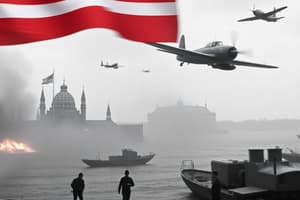Podcast
Questions and Answers
What was the primary reason for Germany's invasion of Poland in 1939?
What was the primary reason for Germany's invasion of Poland in 1939?
- To expand territorial control towards the West
- To establish a route to the USSR (correct)
- To support the Polish government
- To secure military supplies from Poland
Hitler believed the Allies would respond seriously to his aggression against Poland.
Hitler believed the Allies would respond seriously to his aggression against Poland.
False (B)
Who was the Polish commander in chief during the invasion of Poland?
Who was the Polish commander in chief during the invasion of Poland?
Edward Śmigły-Rydz
The German air force that gained superiority over Poland was called the __________.
The German air force that gained superiority over Poland was called the __________.
Match the following names with their roles during the invasion of Poland:
Match the following names with their roles during the invasion of Poland:
Who was the architect of the British victory known for implementing effective air defense strategies?
Who was the architect of the British victory known for implementing effective air defense strategies?
The Luftwaffe was able to successfully establish bases in Spain during World War II.
The Luftwaffe was able to successfully establish bases in Spain during World War II.
What was the significance of Stalingrad in the context of World War II?
What was the significance of Stalingrad in the context of World War II?
The German general who led the forces at Stalingrad was Friedrich von ______.
The German general who led the forces at Stalingrad was Friedrich von ______.
Match the following operations or events with their descriptions:
Match the following operations or events with their descriptions:
What was one of the primary advantages of the German rearmament before the conflict?
What was one of the primary advantages of the German rearmament before the conflict?
Morale of the British people remained low despite heavy bombings during the conflict.
Morale of the British people remained low despite heavy bombings during the conflict.
The date when Stalingrad started was ______.
The date when Stalingrad started was ______.
Flashcards
Lebensraum
Lebensraum
The German concept of 'living space', used as justification for expansion into Eastern Europe. It involved pushing Slavs and Jews out of territories to create space for German settlers.
Blitzkrieg
Blitzkrieg
A German military strategy that involved fast-moving, highly coordinated attacks to overwhelm the enemy quickly. It relied on airpower, armored forces, and focused strikes to cut communication and supply lines.
Operation Sea Lion
Operation Sea Lion
The planned German invasion of England, which was to be launched after gaining air superiority over the Royal Air Force.
Battle of Britain
Battle of Britain
Signup and view all the flashcards
Why did Hitler choose Poland?
Why did Hitler choose Poland?
Signup and view all the flashcards
Radar's Role
Radar's Role
Signup and view all the flashcards
German Secret Service
German Secret Service
Signup and view all the flashcards
Shifting Targets
Shifting Targets
Signup and view all the flashcards
Stalingrad Battle
Stalingrad Battle
Signup and view all the flashcards
Operation Blau
Operation Blau
Signup and view all the flashcards
Soviet Morale
Soviet Morale
Signup and view all the flashcards
Two-Front War
Two-Front War
Signup and view all the flashcards
Study Notes
Invasion of Poland
-
Dates:
- August 31, 1939: Operation staged by the SS to justify attack.
- September 1, 1939: Invasion of Poland (Danzig targeted at 4 am).
- September 2/3, 1939: France and Great Britain declare war.
- Late September: Germans reach Warsaw's outskirts; capture Warsaw on September 27.
- September 17, 1939: Soviet invasion of Poland.
-
Names & Concepts:
- Lebensraum: German concept of "living space," aiming to displace Poles, amongst other Eastern Europeans.
- Luftwaffe: The German Air Force, which gained air superiority.
- Walther von Brauchitsch: Led Operation White (the German invasion plan).
- Blitzkrieg: Fast-moving tactics focusing on cutting off communication and supply lines – lightning war.
- Hans Frank: Administrator of the General Government (occupied Poland).
- Katyn Forest: Site of a massacre of Polish officers by the Soviet Red Army.
- Edward Śmigły-Rydz: Polish commander in chief, deploying troops in a defensive line.
- Maurice Gamelin: Allied commander, who decided not to intervene/support Poland.
-
Points:
- Poland's strategic location, vital to French security, and its route to the USSR, led to its choice as the invasion target.
- Allies' intervention limited to preventing German expansion eastward, as Hitler did not perceive their threat seriously.
- West against Germany, East against the USSR (ethnically cleansing to accommodate Ukrainians/Belorussians).
- Germany's superior population, artillery, and troop strength.
- Poland's lack of industrial capacity to produce or afford modern weapons.
- Poland tried to delay mobilization, to avert war.
- Limited Allied assistance.
-
Importance:
- Triggered Allied involvement in World War II.
- Demonstrated Hitler's willingness to use force and challenge Allied powers.
- Showcased the effectiveness of Blitzkrieg tactics.
Battle of Britain
-
Dates:
- July 19, 1939: Britain rejects Hitler's peace terms.
- July 10, 1940 - October 31, 1940(air attacks into May 3, 1941): The period of air battles.
- September 17, 1940: Operation Sea Lion postponed.
-
Names & Concepts:
- Operation Sea Lion: German plan for a naval invasion of Britain, achieved through air attacks.
- Hermann Göring: Ordered the Luftwaffe's air campaign.
- Spitfires and Hurricanes: Advanced British fighter aircraft.
- R. Watson-Watt: Developed radar, vital for detecting German aircraft.
- Abwehr: German military intelligence.
- Sir Hugh Dowding: British Air Chief Marshal, architect of the British victory.
- Francisco Franco: Spanish general, who refused to allow German bases in Spain.
-
Points:
- First major Allied victory in WWII; greatest air battle.
- German advantages in airpower stemming from the Munich Agreement (Superior aircraft design) but limited by bomb load capacities.
- Forced Nazi spies into allied service
- Adverse weather conditions impacted visibility and air battles.
- Shift of target focus from coastal installations to cities, allowing Britain to rebuild its infrastructure.
- High British morale despite significant casualties (40,000).
-
Importance:
- Critical Allied victory, boosting morale.
- Proved Hitler's forces were not invincible.
Stalingrad
-
Dates:
- May 8, 1942: Preliminary attacks.
- June 20, 1942 – June 22, 1941: 1.2 million German soldiers launched attacks
- July 2: Capture of Sevastopol.
- July 23: Access to Rostov.
- August 22, 1942: Battle begins (inner city by mid-September).
- November 19, 1942: Soviet encirclement of German forces (Hitler refused evacuation).
- December 12, 1942: Relief attempt (Erich von Manstein).
- February 2, 1943: German surrender in Stalingrad, end of battle.
-
Names & Concepts:
- Operation Blau: German offensive aimed at capturing the Caucasus.
- Friedrich von Paulus: German commander at Stalingrad.
- Vasily I. Chuikov: Soviet commander at Stalingrad.
- Operation Uranus: Soviet counter-offensive.
-
Points:
- Stalingrad was a significant industrial center.
- Soviets enforced severe penalties for retreat among their troops.
- Germany underestimated Soviet resolve and fighting capability.
- Hitler diverting forces to North Africa.
- Paulus became a field marshal, but the Germans surrendered.
-
Importance:
- Marked a turning point in the Eastern Front.
- Operation Barbarossa initially surprised Soviets, but failed as the cold weather arrived during the winter.
- Marked the first major Soviet victory.
- Forced Germany to fight a two-front war, hindering their efforts.
- Became the deadliest battle.
Studying That Suits You
Use AI to generate personalized quizzes and flashcards to suit your learning preferences.





